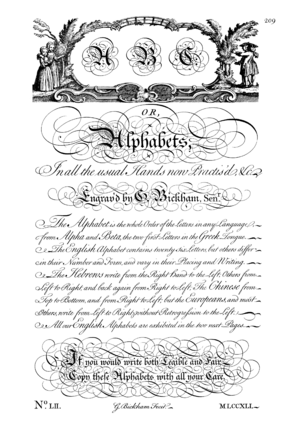George Bickham the Elder facts for kids
George Bickham the Elder (1684–1758) was an English writing master and engraver. A writing master taught people how to write beautifully. An engraver carves designs onto metal plates. He is most famous for his engraving work in a book called The Universal Penman. This book was a collection of perfect writing examples. It helped make the English Round Hand style of writing very popular in the 1700s.
Bickham created special copybooks and business guides. In the 1600s and 1700s, learning to write was closely linked to mathematics. This included subjects like arithmetic and bookkeeping.
The Universal Penman
In 1733, Bickham gathered writing samples from 25 London writing masters. He then engraved and published them in The Universal Penman. This huge collection was released in 52 parts between 1733 and 1741.
The book quickly became one of the most important and popular guides. Writing masters used it to teach their students. Today, calligraphers still use it to learn the English Round Hand or Copperplate script. The book was even reprinted as recently as 2014.
Many examples in Bickham's Universal Penman showed how important good writing was. It was especially important for young men working in business or government. But there were also parts for women and girls. For example, a poem from 1734 said that bad writing was a shame for a beautiful writer. It said: “An artless Scrawl ye blushing Scribler shames; All shou’d be fair that Beauteous Woman frames.” Another piece hinted that beautiful writing might even help with romance: “Strive to excel, with Ease the Pen will move; And pretty line add Charms to infant Love.”
Working with His Son
George Bickham had a son, also named George Bickham the Younger. His son followed in the family business of engraving. He specialized in engraving pictures and music sheets.
Father and son worked together on several publications. These included The Universal Penman and The British Monarchy. The British Monarchy was a collection of 188 plates of historical notes. It also had 43 plates showing views of English and Welsh counties. These were called "views" instead of maps. But they looked like maps with major towns marked.
Sources
- Monaghan, J. E.. Learning to read and write in colonial America, Boston, MA: University of Massachusetts Press, 2005. ISBN: 1558495819
- Van Zuylen, Sybille. Penna Volans.


